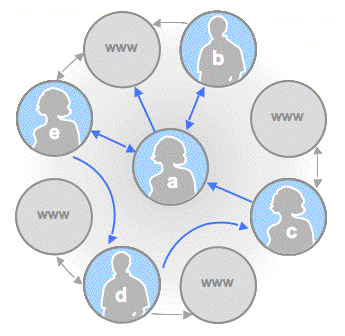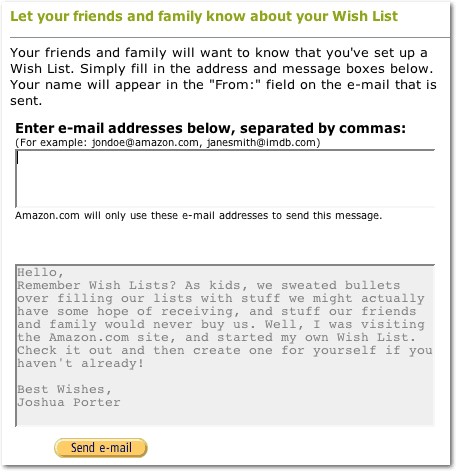August 25th
A thought on Amazon’s new product page design
Amazon has designed themselves into a Local Maximum but mobile and tablet use will help get them out of it.
Continue Reading: A thought on Amazon’s new product page design
TAG: Amazon
August 25th
Amazon has designed themselves into a Local Maximum but mobile and tablet use will help get them out of it.
Continue Reading: A thought on Amazon’s new product page design
February 8th
People like me features are one of the most promising ways to help people find content that is interesting to them.
Jason Kottke points to a study in which researchers found evidence that the brain reacts differently to people who seem like us.
This isn’t surprising, of course. We do tend to react differently when we feel like we’re around a like-minded person.
But how can this help inform design?
Continue Reading: The Importance of “People like Me” features
February 3rd
The Google Social Graph API is a new programming API that allows developers to expose social relationships embedded in web sites. What does this mean for regular folks like you and me? Read on.
Do you ever feel like your personal information is spread across the web in a whole bunch of separate places? An account here, a profile there? A friends list here and a friends list there? All your information, but in all different places all incomplete at the same time?

The Social Graph API helps solve this “silos of information” problem by allowing people to write software that understands who your friends are. It does this by reading your web site or blog and making connections between the social profiles you have across the web.
For example, imagine you have a blog, which is your home on the web. You also have an Amazon profile, a Twitter profile, and a Facebook profile. So you have four profiles spread across the web, seemingly unconnected. Amazon has no idea who your friends on Facebook or Twitter are, and vice-versa, and this is a good thing from a privacy standpoint. These sites shouldn’t be able to find out everything about you with you giving them permission.
But what if you wanted these sites to know a bit about each other? What if you want to combine your Amazon book history with your friends lists at Facebook so that you can see what your friends are reading and let Amazon give you recommendations based on your similarity with them? Or, perhaps you just joined Twitter and want to know which of your Facebook friends are already there so you don’t have to go hunting for them? (see video) Here we see real-world examples of how cross-pollinating your personal information between these sites can not only be efficient, but desirable…
Continue Reading: Why I’m excited about the Google Social Graph API
January 13th
In this New York Times piece Putting Buyers First? What a Concept (hat tip Mark Hurst), author Joe Nicera, while describing a positive experience with the company, drops an absolutely astounding number:
52% of people who shop online do product research at Amazon.com
And, perhaps even more amazing is that what those shoppers are going for isn’t even provided by Amazon: customer reviews. Nope, much of the valuable information on the site is provided by other people who write reviews, describe their experiences, and help others watch out for bad products.
That’s the power of social interaction. While we probably listen to the people selling us products some of the time, what we’re really interested in is what other people like us have to say.
Unbiased, unvarnished, authentic voices. Are you designing for them?
Continue Reading: Fifty Two Percent
December 12th
Before anybody claims that I am an Amazon fanboy (as I reference Amazon *a lot* in my talks), let me just say that in addition to some really great design they also have areas to improve on. Here’s a particularly baffling one: wish list sharing.
Sharing is crucial in social design. It allows people to share your application/service/web site with others in a way that you as the designer can’t. What other people say about you is an order of magnitude more powerful than what you can say about you.
If you don’t have smooth, easy process for sharing you are hampering the growth of your app. Sure, people will share to some extent on their own, but why force them to? When someone sends a personal, relevant message sharing something, the recipient will take notice. Make that as easy as possible.
Here is the sharing form for Amazon’s wish lists. It’s a typical sharing form: a bit of explanatory text, an email field, and a message.

But for some reason, and I can’t for the life of me figure out why, Amazon doesn’t let you edit the message. And they really should, as the message suffers from several problems…
Continue Reading: Amazon Wish List Sharing gets it Wrong
December 3rd
A conversation I had today rewired the idea of the Long Tail for me.
The Long Tail, or the death of the product shelf (where shelf space becomes irrelevant when content is digital) brought on tremendous change in the economics of distribution. Netflix rents most of its movies from the catalog of past movies, not from the current list of blockbusters. Same with Amazon and books, iTunes and music. Christopher Anderson goes into a lot more details in the book he wrote on the subject: The Long Tail.
When content is digital, a public good, it is freely distributable by electronic means. It is infinitely copyable at 100% fidelity. Moreover, as the Long Tail shows, libraries of content can be built cheaply which provide value for the long term. Once Google digitizes all the books in the world they won’t ever have to again.
In other words, all content is available at all times.
What does this lead to? The Paradox of Choice! There are simply too many things to choose from. Which of the thousands of movies on Netflix do I rent? Which of the books on Amazon do I read? Which of the songs on iTunes do I listen to?
In the past, we listened to either the creator or the distributor for help. Since choice was limited, they would steer us to something in their limited selection. You either went to one of the movies at the local theater, or you didn’t watch a movie. You either bought a book from the book store or checked one out of the library, or you didn’t read. If you were lucky enough to be near a creator (like a rock band) you either went to the pub to listen to them or you went without live music.
The creator and the distributor, however, had a problem. They were always and forever biased…
Continue Reading: Did the Long Tail Beget Social Design?
November 27th
Just in time for the holidays, I’m releasing a much requested feature here at Bokardo:
Over the past few months, lots of folks have asked me for a social design reading list. I started putting one together a while back, but it’s a lot more work than I originally anticipated. It’s hard to put together a decent list of books on a subject that doesn’t quite exist while also keeping that list to books you’re familiar with while also making sure those books are good.
As you browse the reading list, you’ll notice a few things. One is that almost all the books are soft-cover and relatively inexpensive ($10-$20). I tried to include easy-to-read books that you can take with you while traveling or actually hold up in bed. Second, you’ll notice there are only a few books on social theory and design. That’s because there just aren’t that many! I have included a lot of other web & interface design/development books I have found value in, so this isn’t exclusively a social design reading list. And, of course, people building social web applications have to do all the other parts of design as well.
If you do know of some books that should be added to the list, please let me know either in the comments or by contacting me. So far I’ve kept the list to books that I know and have read (at least parts of all of them). I’m sure there are others, but I didn’t want to include all books about social media, I only wanted to include the very best ones.
Why did I do this as an Amazon astore?
Continue Reading: Social Design Reading List
November 14th
Armin Vit at Speak Up asks: Where are the canonical web designs?
“Milton Glaser’s Dylan poster. Paul Rand’s IBM logo. Paula Scher’s Public Theater posters. Massimo Vignelli’s New York subway map. Kyle Cooper’s Seven opening titles. These are only a few landmark projects of our profession. Design solutions that, in their consistent use as exemplary cases of execution, concept and process, don’t even need to be shown anymore and that, for better or worse, (almost) everyone acknowledges as being seminal works that reflect the goals that graphic design strives for: A visual solution that not only enables, but also transcends, the message to become memorable in the eyes and minds of viewers. Whether these projects are indeed as amazing, relevant and enviable as we have built them up to be is cause for a separate discussion but it’s safe to say that, as far as designs recognized around the profession, there are a certain few that invariably make the list, usually without question. Myself, I could list projects in every category from logos, to annual reports, to magazine covers, to packaging, to typefaces, to opening titles that could be considered landmark projects… But when it comes to web sites, I can’t think of a single www that could be comparable — in gravitas, praise, or memorability — as any of the few projects I just mentioned. Could this be?”
Armin then goes and mentions the obvious answer: Google.
But this is not an acceptable answer for him, because…wait for it…the logo sucks.
To talk about Google in terms of its logo has long been a pastime for people who care about logos. For years I’ve heard the same argument from people who want nothing more than to get rid of the “Mickey Mouse” logo, as it is often described.
Armin’s point is that while Google seems to be better than Yahoo, it is still plagued with a bad logo. He’s not “moved or inspired” by the design. Therefore, he reasons, it is not canonical design. Canonical design, in his mind, is one that practitioners of the medium look to as exemplary.
But, frankly, I think Armin has missed his own point…
Continue Reading: Do Canonical Web Designs Exist?
October 15th
Is it possible to read 7 books in a day…every day?
Continue Reading: Is Harriet Klausner for real?